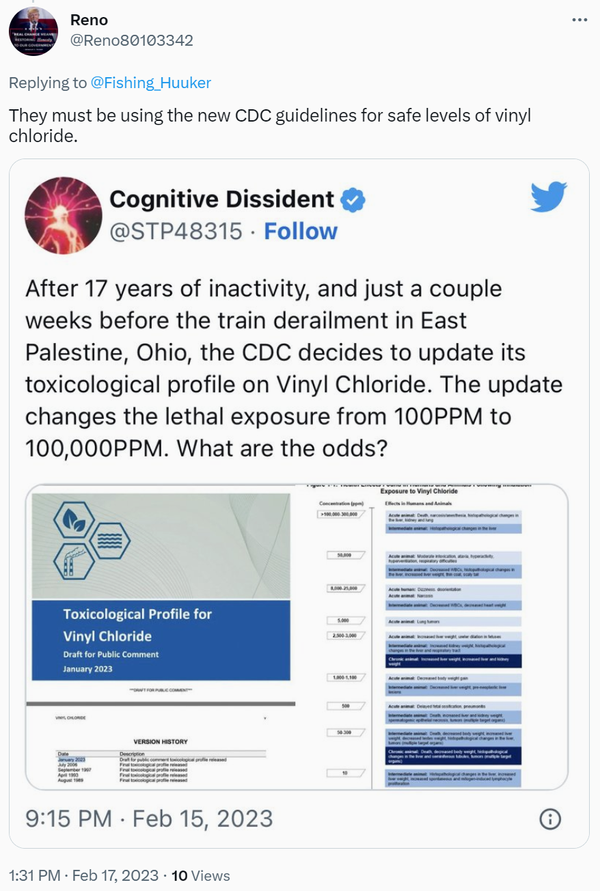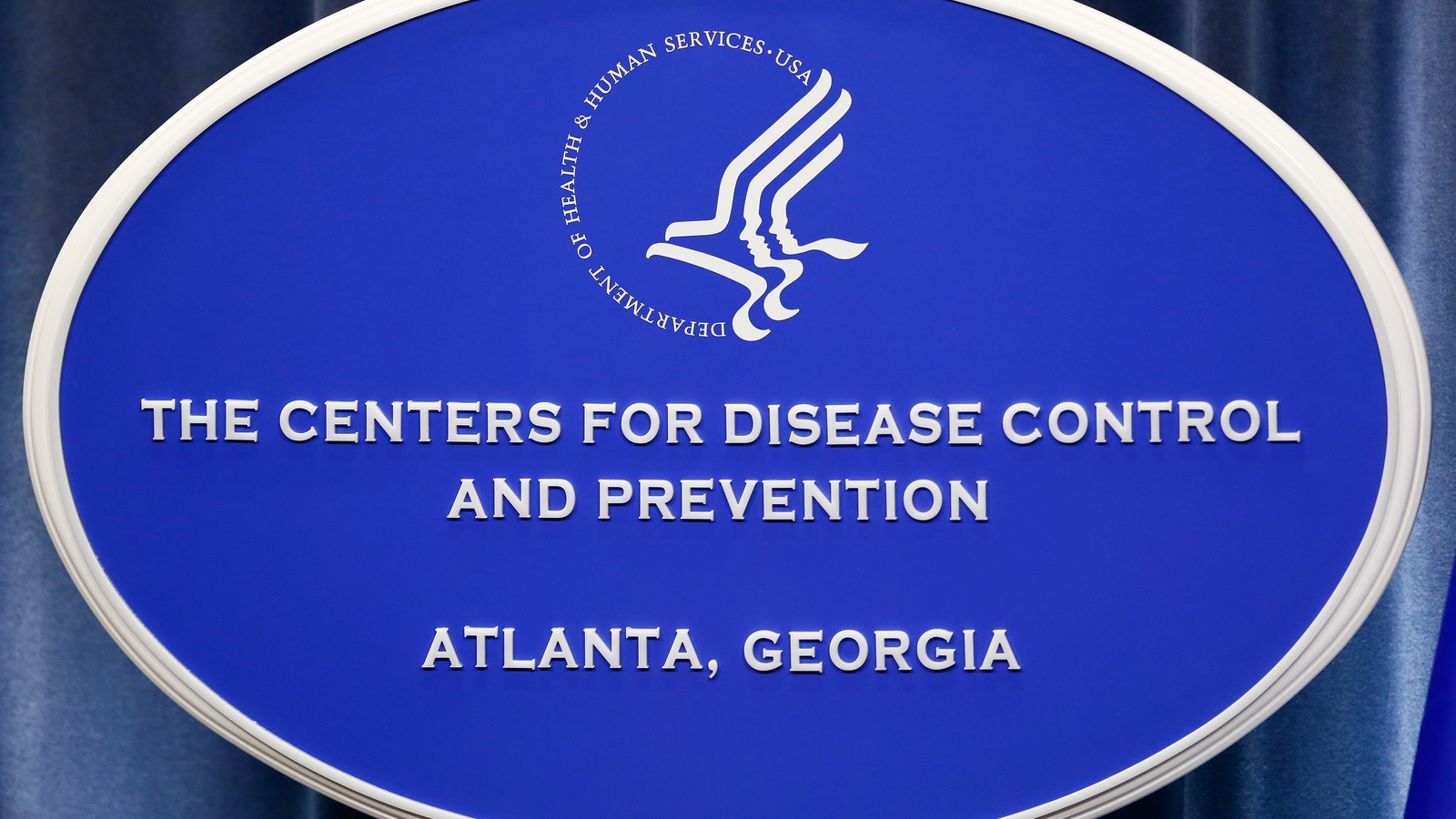Did CDC Raise ‘Lethal Exposure’ Level of Vinyl Chloride Days Before Ohio Train Derailment?
The U.S. Centers for Disease Control and Prevention increased what it considers the “lethal exposure” threshold of vinyl chloride, a toxic chemical released due to the February 2023 Ohio train derailment, mere days or weeks before the incident.
Major disasters often spawn conspiracy theories, and the derailment of a train carrying toxic chemicals in East Palestine, Ohio, in February 2023 proved no exception.
In the aftermath of that incident, even as authorities labored to evaluate the health and environmental impacts of the release of vinyl chloride and other hazardous substances into the atmosphere, fringe news websites and social media accounts began raising alarms over the timing of what they termed a “suspicious” update to the toxicological profile of vinyl chloride on the website of the U.S. Centers for Disease Control and Prevention (CDC).
The premise of this conspiracy theory was that the CDC had suddenly and inexplicably, just days before the Ohio train derailment, revised the information about vinyl chloride on its website to indicate the chemical is far less toxic than previously stated. But while it’s true that the CDC updated information about vinyl chloride on its website around the date of the accident, those updates did not drastically reevaluate the toxicity of vinyl chloride, nor was there anything sudden, inexplicable, or suspicious about the timing.
‘I’m Not a Conspiracy Theorist, but …’
The derailment occurred on Feb. 3, 2023. To forestall a likely explosion, authorities initiated a controlled release and burn-off of the hazardous chemicals on the train on Feb. 6, which sent a massive plume of black smoke into the atmosphere. Confusion reigned in the days to follow, as local residents watched the sky, drank bottled water, and feared for their lives, while government health officials repeated assurances that they had found no evidence of dangerous levels of chemicals in the air or water.
On or about Feb. 15, rumors began to spread on social media that the CDC had suddenly and unaccountably revised its guidance on what constitutes a dangerous level of vinyl chloride, and that it had done so just 11 days before the East Palestine train crash:

The claim became more specific as it made the rounds. “The update changes the lethal exposure from 100PPM to 100,000PPM,” said one tweet. “What are the odds?”

On Feb. 17, the conspiracy theory-friendly website News Punch published an article entitled “‘Inside Job’: CDC Changed Toxicity Info on Vinyl Chloride Days Before Derailment.”
It claimed that:
The CDC edited the toxicology profile for vinyl chloride, massively increasing the lethal exposure level and removing information about how the chemical affects children, just two weeks before the train derailment in East Palestine, Ohio that spewed vast quantities of the chemical into the environment.
The CDC update changed the lethal exposure from 100PPM to 100,000PPM. The lethal exposure level had remained the same for 17 years before the CDC decided to update the number just prior to the derailment, where highly toxic chemicals spilled or were burned off, leaving a chemical stench in the air nearly two weeks later.
[ … ]
Evie Magazine report: In January 2023, the toxicological profile for vinyl chloride was revised from the original guidelines published in the Federal Register nearly four decades ago – on April 17, 1987, to be exact. While toxicological profiles are updated occasionally, users are alarmed by the odd timing.
Let’s Look at the Facts
FACT: The “edited profile” that caused all the ruckus was a clearly labeled draft released for public comment only.
On Feb. 9, 2023, the CDC added a link on its website to a draft of an updated version of its existing Toxicological Profile for Vinyl Chloride, which had been in effect since a previous update in 2006 (not four decades ago, as claimed). As noted on the access page for the updated profile, this was not a final draft. It was posted for the purpose of gathering public comment (comment period to end May 10, 2023) before completion. According to the Agency for Toxic Substances and Disease Registry (ATSDR, the CDC agency charged with assessing the toxicity of substances), toxicological profiles are peer-reviewed summaries of published findings in the scientific literature about specific chemicals of concern. “The toxicological profiles include an examination, summary, and interpretation of available toxicological and epidemiologic information on substances.” Profiles are evaluated annually to determine whether updating is necessary.
FACT: There was nothing odd, suspicious, or sinister about the timing of this release. Three other draft toxicological profiles were released the same day.
The CDC’s Feb. 9 draft vinyl chloride updates occurred six days after the East Palestine train derailment, and three days after the controlled release of vinyl chloride. The PDF file of the draft toxicological profile was created in January, mere weeks or days before the accident. Was there anything odd or uncanny about this? Quite the opposite. The vinyl chloride update was just one of four such updates announced by the CDC on the same day (Feb. 9). In each case, existing website copy was revised and a link was added to a draft profile of the relevant substance dated January 2023. Moreover, according to ATSDR, toxicological profiles can take more than a year to update, so revising the profile for vinyl chloride was not a sudden, last-minute decision.
The four profile releases were also announced in the Feb. 9, 2023, edition of the Federal Register:
DEPARTMENT OF HEALTH AND HUMAN SERVICES
Agency for Toxic Substances and Disease Registry
[Docket No. ATSDR–2022–0006]
Availability of Four Draft Toxicological Profiles
AGENCY: Agency for Toxic Substances and Disease Registry (ATSDR), Department of Health and Human Services (HHS).
ACTION: Notice with comment period.
SUMMARY: The Agency for Toxic Substances and Disease Registry (ATSDR), within the Department of Health and Human Services (HHS), announces the opening of a docket to obtain comments on drafts of four updated toxicological profiles: Cobalt, Hexachlorocyclohexanes, 1,1,1-Trichloroethane, and Vinyl Chloride.
DATES: Written comments must be received on or before May 10, 2023.
FACT: The draft profile did not drastically increase the “lethal exposure level” for vinyl chloride.
We note, first, that the phrase “lethal exposure level” is nowhere to be found in either the existing (2006) profile or the 2023 draft profile. Nor did we find an instance wherein an exposure level deemed lethal at 100 ppm (parts per million) in 2006 was raised to 100,000 ppm in 2023. In fact, the only statement along these lines we did encounter appeared in both versions in almost identical form:
2007:
Brief exposures to concentrations of vinyl chloride ranging from 100,000 to 400,000 ppm have been
shown to be fatal in experimental animals such as rats (Lester et al. 1963; Mastromatteo et al. 1960;
Prodan et al. 1975), guinea pigs (Mastromatteo et al. 1960; Patty et al. 1930; Prodan et al. 1975), mice
(Mastromatteo et al. 1960; Prodan et al. 1975), and rabbits (Prodan et al. 1975). At these concentrations,
deaths occurred within 30–60 minutes. Male mice exposed to 30,000 ppm vinyl chloride 6 hours/day for
5 days, in a dominant lethal study showed an increased mortality rate (Anderson et al. 1976). An
increased mortality rate was also observed at much lower concentrations in maternal mice in a
developmental toxicity study (John et al. 1977, 1981). In this study, maternal mice had an increased
incidence of deaths following exposure to 500 ppm for 10 days during gestation.
2023:
Brief exposures to concentrations of vinyl chloride ranging from 100,000 to
400,000 ppm have been shown to be fatal in rats (Lester et al. 1963; Mastromatteo et al. 1960; Prodan et
al. 1975), guinea pigs (Mastromatteo et al. 1960; Patty et al. 1930; Prodan et al. 1975), mice
(Mastromatteo et al. 1960; Prodan et al. 1975), and rabbits (Prodan et al. 1975). At these concentrations,
deaths occurred within 30–60 minutes. An increased mortality rate was also observed at much lower
concentrations in maternal mice in a developmental toxicity study (John et al. 1977, 1981). In this study,
mortality was observed following exposure to 500 ppm for 10 days during gestation.
In short, the revised information about vinyl chloride was part of the planned release by the CDC of four draft toxicological profiles, all dated January 2023, for public comment; the proximity of that release to the date of the Ohio train derailment was coincidental; and the 2023 draft profile for vinyl chloride does not contain a dramatic increase in the level of exposure to the chemical that is considered lethal.
Snopes contacted the CDC for comment and received the following response via email, quoted here in full:
Thank you for reaching out to CDC on this request.
By Congressional mandate, the Agency for Toxic Substances and Disease Registry (ATSDR) produces and updates toxicological profiles (Tox Profiles) for chemical substances found on its Substance Priority List (SPL) at National Priorities List (NPL) sites. The Comprehensive Environmental Response, Compensation, and Liability Act of 1980, as amended (CERCLA or Superfund), further requires that toxicological profiles be updated periodically. ATSDR evaluates profiles annually to determine whether updating is necessary. Depending on the complexity of the chemical, the process for developing a Tox Profile can take up to a year or more. This includes multiple reviews, such as external, independent peer review followed by release for a 90-day public comment period, and incorporating any necessary changes and final publishing.
ATSDR developed the initial vinyl chloride Tox Profile in 1989 and produced updates in 1993, 1997, 2006, and 2023 based on the latest information published in the scientific literature.
ATSDR has been working on an update to the Vinyl Chloride Tox Profile over the past year, and made it available for public comment on 2/9/2023 as part of its usual process and not related to the emergent situation in East Palestine. The draft Tox Profile is available for public comment until May 20, 2023. It updates the 2006 version with the most recent information.
Vinyl chloride has a total of 3 minimal risk levels (MRLs), of these, only 1 (intermediate-duration inhalation) has been revised from the 2006 vinyl chloride Tox Profile as a result of new modelling information.
This article has been archived for your research. The original version from Snopes Fact Checks can be found here.



